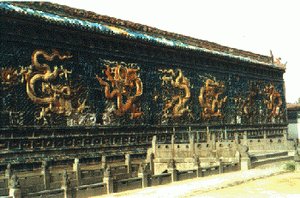
The Nine-Dragon Screen is localted in the downtown of Datong.
Nine Dragon Screen, or Jiulongbi, was built in the early Ming Dynasty (1368-1644) in front of the residence of Zhu Guidai, the thirteenth son of the first Ming Dynasty em peror, Zhu Yuanzhang. The screen was constructed of glazed tiles and still remains intact today. It is over 350 years older and three times larger than the one in Beihai Park in Beijing.
With a history of more than 600 years. It is the largest Nine-Dragon Screen of China. On the 3 story high grand wall 426 pieces of colour glazed tiles were put together to form the pattern of Nine Dragons, the Sun, the Moon, cloud and mountains.
The pedestal is rectangular shaped with a height of 2.09 meters (6.9 feet). Its narrow middle section is composed of 75 glazed tiles with images of oxen, dogs, deer rabbits and other animals.
The design of the body is that of a green wave on the lower part and a blue and yellow cloud on the upper part. It consists of nine flying dragons, with a golden-scaled, shiny-eyed dragon located in the center. On each side of the central dragon is a pair of light yellow dragons with their heads pointed East and tails pointed towards the central dragon.
A second pair of elegant yellow dragons is next with their heads and tails pointed west. A third pair is ferocious-looking purple dragons which seem to be wrestling with the sea. The fourth pair is highly spirited dragons. The nine dragons are life-like and illustrating their ability of calling the wind and controlling the rainfall.
The areas around the dragons are supplemented with images of plants, mountains, stones, water and grass. These patterns along with the nine dragons compliment each other.
The roof is covered with glazed tiles.
